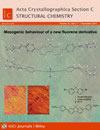Using cocrystals as a tool to study non-crystallizing molecules: crystal structure, Hirshfeld surface analysis and computational study of the 1:1 cocrystal of (E)-N-(3,4-difluorophenyl)-1-(pyridin-4-yl)methanimine and acetic acid.
IF 0.7
4区 化学
Q4 CHEMISTRY, MULTIDISCIPLINARY
Acta Crystallographica Section C Structural Chemistry
Pub Date : 2024-08-01
Epub Date: 2024-07-05
DOI:10.1107/S2053229624005187
引用次数: 0
Abstract
Using a 1:1 cocrystal of (E)-N-(3,4-difluorophenyl)-1-(pyridin-4-yl)methanimine with acetic acid, C12H8F2N2·C2H4O2, we investigate the influence of F atoms introduced to the aromatic ring on promoting π-π interactions. The cocrystal crystallizes in the triclinic space group P1. Through crystallographic analysis and computational studies, we reveal the molecular arrangement within this cocrystal, demonstrating the presence of hydrogen bonding between the acetic acid molecule and the pyridyl group, along with π-π interactions between the aromatic rings. Our findings highlight the importance of F atoms in promoting π-π interactions without necessitating full halogenation of the aromatic ring.
利用共晶体作为研究非结晶分子的工具:(E)-N-(3,4-二氟苯基)-1-(吡啶-4-基)甲亚胺和乙酸的 1:1 共晶体的晶体结构、Hirshfeld 表面分析和计算研究。
利用 (E)-N-(3,4-二氟苯基)-1-(吡啶-4-基)甲亚胺与乙酸(C12H8F2N2-C2H4O2)的 1:1 共晶体,我们研究了引入芳环的 F 原子对促进 π-π 相互作用的影响。该共晶体呈三菱空间群 P1。通过晶体学分析和计算研究,我们揭示了这种共晶体内的分子排列,证明了乙酸分子和吡啶基之间存在氢键,以及芳香环之间存在π-π相互作用。我们的研究结果凸显了 F 原子在促进 π-π 相互作用方面的重要性,而无需对芳香环进行完全卤化。
本文章由计算机程序翻译,如有差异,请以英文原文为准。
求助全文
约1分钟内获得全文
求助全文
来源期刊

Acta Crystallographica Section C Structural Chemistry
CHEMISTRY, MULTIDISCIPLINARYCRYSTALLOGRAPH-CRYSTALLOGRAPHY
CiteScore
1.60
自引率
12.50%
发文量
148
期刊介绍:
Acta Crystallographica Section C: Structural Chemistry is continuing its transition to a journal that publishes exciting science with structural content, in particular, important results relating to the chemical sciences. Section C is the journal of choice for the rapid publication of articles that highlight interesting research facilitated by the determination, calculation or analysis of structures of any type, other than macromolecular structures. Articles that emphasize the science and the outcomes that were enabled by the study are particularly welcomed. Authors are encouraged to include mainstream science in their papers, thereby producing manuscripts that are substantial scientific well-rounded contributions that appeal to a broad community of readers and increase the profile of the authors.
 求助内容:
求助内容: 应助结果提醒方式:
应助结果提醒方式:


